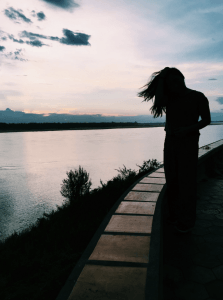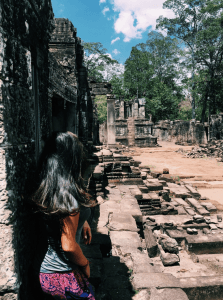Every year at my high school, each grade had a designated trip to go on. The freshman got the chance to go to China, sophomores had a hiking trip in the Northern Sierras, and juniors and seniors got the opportunity to pick their trip. My junior year, I decided on going to Cambodia. This trip included a homestay portion, something very unique to do in any country. I have previously done a homestay trip before, in China, but felt more comfortable going into that because there was not a language barrier for me. Feeling a little nervous about that portion of the trip, I decided that I was not going to let it affect me. I was going to go to Cambodia with some of my best friends from school, and that was an incredibly rare opportunity.
The flight was 20 hours long. We left our school at around 3 in the morning to catch our flight in Los Angeles. We first flew to South Korea for a quick layover. Then, we made it to our first destination: Phnom Penh. Phnom Penh is Cambodia’s capital, and one of the most developed cities in the country. The weather was completely different from San Diego. It was extremely hot and humid, and there was no shortage of mosquitos.
Cambodia is a pretty conservative country, so we were all wearing elephant pants or harem pants. We also had to make sure our shoulders were properly covered. Like most parts of Southeast Asia, the head is considered the most spiritual part of the human. On the other hand, the feet are considered the dirtiest and the lowest part in terms of sacredness. With this in mind, when we sat on the ground, we had to make sure that our feet were always tucked in and not pointed at someone. These common etiquettes are different from what we see in America, and to see a country where mindfulness is extremely important just shows how different societies are.
In Phnom Penh, we learned about the Khmer Rouge. This is an extremely sensitive subject in the country as it was 3 years of genocide. This still effects the country as there are thousands of survivors still living with the horrors what happened and ongoing trials against many leaders. Pol Pot, the tyrant that led the regime is often compared to the likes of Hitler and Stalin. He believed that Cambodia needed to be rid of royalists and intellectuals. Along with killing 1.7 million Cambodians, they rid the country of books and almost all things educational. As part of learning about Cambodia’s past and the genocide, we visited Tuol Sleng Genocide Museum and the Choeung Ek Killing Fields. Tuol Sleng was a Khmer Rouge detention and torture camp. It was once a high school before turning into a prison in 1975. There, we saw the holding cells, gallows, and recollections of what the prisoners went through.
Next, we visited Choeung Ek, where the bodies of millions of people were disposed of. There are about 9,000 bodies still in mass graves. Many victims were not spared with bullets, many were killed by pickaxes or cart axles so that the soldiers could save bullets. Infants were thrown into pits and defenseless men and women were killed against this big beautiful tree. Walking through the Killing Fields was deceivingly beautiful. The day was not too hot, and the large and plentiful trees provided plenty of shade. There was a soft breeze flowing through the whole place, providing perfect weather. There was a large square pond surrounded by beautifully carved stone structures. It was unbelievable to think that this place was once an extermination camp, where thousands of people were detained and tortured.
Walking through the museum and the killing fields was absolutely horrifying. I saw cases of skulls belong to victims, bones in the dirt, and reading journal entries all opened my eyes to the horrors of the country’s past. I grew up in a family and community that valued education over almost everything. I was privileged enough to go to a private school, and now one of the best universities in America. For a whole country to believe one man’s belief of ridding anyone with an education was unthinkable. What I could not believe even more was the fact that it was my peers’ and I’s first-time learning about this genocide. Every high schooler in America learns about the Holocaust, but not even a mention about the Khmer Rouge. Especially because it affects education, the idea that more people are not learning about it is completely shocking.
After an emotional and eye-opening time in Phnom Penh, we left for Koh Pdao, an island in Kratie. It was time for our homestay. We stayed a total of 7 days on the island. We in huts made of straw and wood elevated on wooden beams. The island was beautiful. We ate with our homestay families every day and they were all incredibly kind. It is amazing how human to human understanding can lead to communication between people who do not speak the same language. I feel as if I had full conversations with my host family just through showing pictures and using my hands. The language barrier did not deter from my experience at all. On the island, my peers and I helped to start and finish a garden in the mayor’s house. It was one of the most labor-intensive things I have ever done, but to see how happy the locals were made it worth it all. After my time there, it was very hard to leave. I formed strong bonds with many of the children there and had one of the best experiences. I learned so much about the culture and what rural life is like in Cambodia. When we got on our boat to return to the mainland, I looked back and looked at my host mom crying. To see her cry made me think of the good times that we had together and made myself very emotional as well.
Once we completed the homestay portion of our trip, our time in Cambodia was coming to an end. Our last stop was Siem Reap, also known as a resort town. Here, we stayed at a hostel. This hostel was also the home to hundreds of amputees. Cambodia has a landmine problem, which was left after three decades of war. These landmines are anti-personnel landmines, meaning that they explode upon contact. It is extremely expensive to remove, which is a problem for the poor country. Staying at this hostel was just a reminder of how many problems the country’s war-torn past has left the current population.
Here in Siem Reap, the major attraction we saw was Angkor Wat. Angkor Wat is just as beautiful as the pictures show them as. To get there, we had a 14-mile bike ride through the busy streets of Siem Reap. The trip was extremely tiring, but in the end very rewarding. Walking through the temple and the largest religious monument in the world was surreal. The whole trip was very heavy in terms of all of the things we were learning, so it was very nice to take a break from it all and just enjoy the beauty of Cambodia.
On our bike ride back to our hostel, I was actually hit by a motorbike. I escaped from the accident with just a few scratches, but it was amazing to see how quickly the locals jumped to help me. Local store owners ran into their stores and returned with ointments to apply onto my scratches and others called the cops to report what happened. To see how willing everyone was to help me, some random tourist, was extremely touching.
On our last night in Cambodia, we learned about another issue affecting the country. With many celebrities such as Angelina Jolie adopting children from third world countries and adoption becoming a large part of many countries, orphanages are opening up in many of these countries. In Cambodia, many of these orphanages are corrupt. Orphanage tourism hurts children and families. Many of these orphans are starved and forced to perform for tourists visiting. They are beaten by the directors, and all of the clothes and toys donated are all just sold so that the directors can pocket the money. Many poor families sell their children to orphanage directors so that they can have the money and hope that their children will get adopted by better families. The reality is that most of these children do not get adopted and just suffer through years of abuse. While many organizations and countries have good intentions in supporting these orphanages, they are actually hurting families and removing children from homes. It is difficult to stop this as many people just do not know the truth behind these orphanages.
The whole trip opened my eyes to so many issues. Social justice is not something easily achieved and many problems just cannot be solved easily. I learned that the best way for me to help these people is to educate. I believe that it is my duty now to educate as many people as I can about some of these deep-rooted issues. Money cannot solve most of these problems, and it is up to everyone to learn and try to help. That is why travel is so important to me. Without visiting and seeing everything for myself, I cannot do much. My trip to Cambodia has led me to learn some of the most valuable information and issues that years of schooling have failed to teach me. This was one of my best travel experiences, and I hope to revisit in the future.







